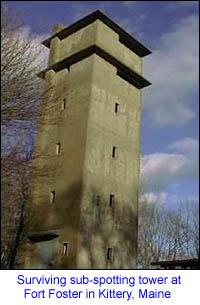|
FRESH STUFF DAILY |
|
|
||
|
|
||
|
|
||
|
SEE ALL SIGNED BOOKS by J. Dennis Robinson click here |
||
Page 1 of 3
During the 20th century deadly mines were planted along the floor of the Piscataqua connecting NH and Maine. Although none were detonated, ten men died when a mine-planter sank off the Isles of Shoals. This is the story of the Richard Arnold by reader request.
JUMP to newspaper account One little-known fact about WW2 is that the Army had more ships that the Navy! A reader recently asked us about the sinking of a mine-planter shipping off the Isles of Shoals in January 1942. We had not heard the story. Historian Richard Winslow located the report in the Portsmouth Herald archives and it is reprinted below. The Sinking of the Gen. Richard Arnold
Little known and rarely honored, Army ships mined key American harbors including Portsmouth, New Hampshire during wartime as part of an elaborate coastal defense network. Remnants of the WW2 era forts survive in New Castle and Rye and Kittery. Visitors can still see them at Fort Stark, and Fort Foster from which mines were strung below the Piscataqua, ready to be triggered electronically. None were ever activated. Mines were set off, not by contact with the enemy ship, but by wired systems set off by observers in the watchtowers. Although none of the mines were ever deployed, a number of the coastal defense observation towers still stand along the Seacoast. Small mine-planters, some pre-dating the First World War were used to lay the cables and junction boxes that would set off the mines. The junior mine-planter Gen. Richard Arnold was apparently named for a Civil War Union brigadier general (1828-1882) Lester Stevens, now living in Rye, NH, was assigned to the ARNOLD on the day of the disaster, but told the local newspaper recently that he was kept back to perform KP duties. He learned hours later that his entire crew had perished in the rescue attempt in 20-foot waves. Their bodies were never recovered. – J D Robinson Continue with MINE-PLANTER TRAGEDY
Please visit these SeacoastNH.com ad partners.
News about Portsmouth from Fosters.com |
| Wednesday, April 24, 2024 |


|
Copyright ® 1996-2020 SeacoastNH.com. All rights reserved. Privacy Statement
Site maintained by ad-cetera graphics

 The Shipyard
The Shipyard




 Ten crewmen died when the ancient ship GENERAL RICHARD ARNOLD, built in 1909, sprang a leak in a storm. The ARNOLD sank after successfully saving another Army mine-planter that had suffered engine trouble while heading to Portsmouth. Originally eight crewmembers, mostly civilians, were reported lost. The next day that number was increased to ten. Only the commander survived when he jumped into the water and was rescued. Witnesses later reported that the captain had bravely called to rescuers, "Never mind me. Save the others!" as he floundered in the icy waters.
Ten crewmen died when the ancient ship GENERAL RICHARD ARNOLD, built in 1909, sprang a leak in a storm. The ARNOLD sank after successfully saving another Army mine-planter that had suffered engine trouble while heading to Portsmouth. Originally eight crewmembers, mostly civilians, were reported lost. The next day that number was increased to ten. Only the commander survived when he jumped into the water and was rescued. Witnesses later reported that the captain had bravely called to rescuers, "Never mind me. Save the others!" as he floundered in the icy waters.














